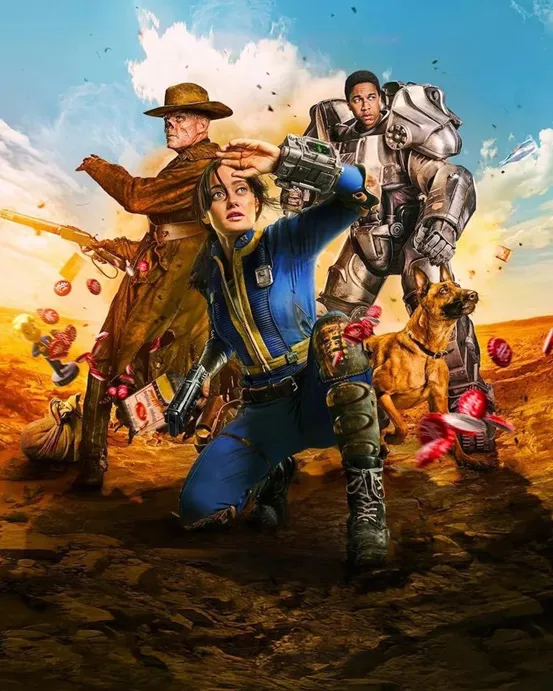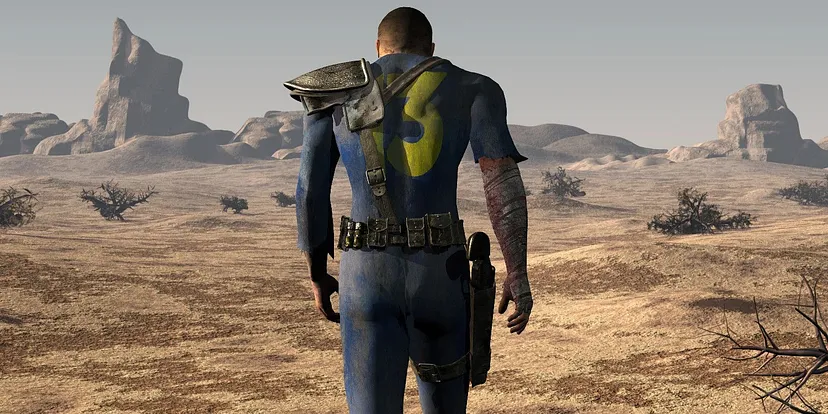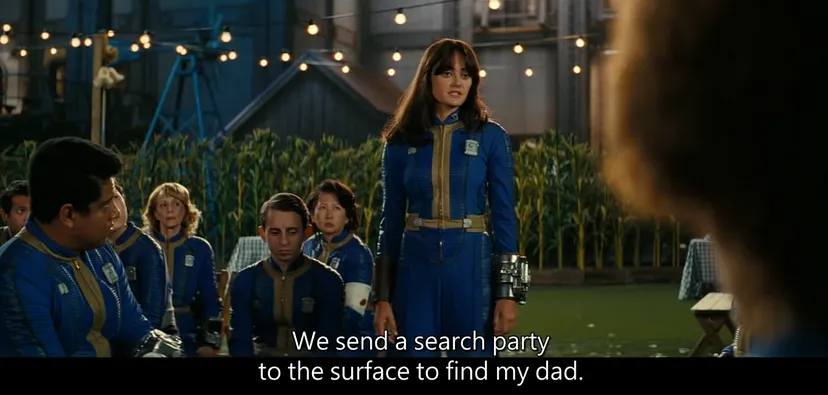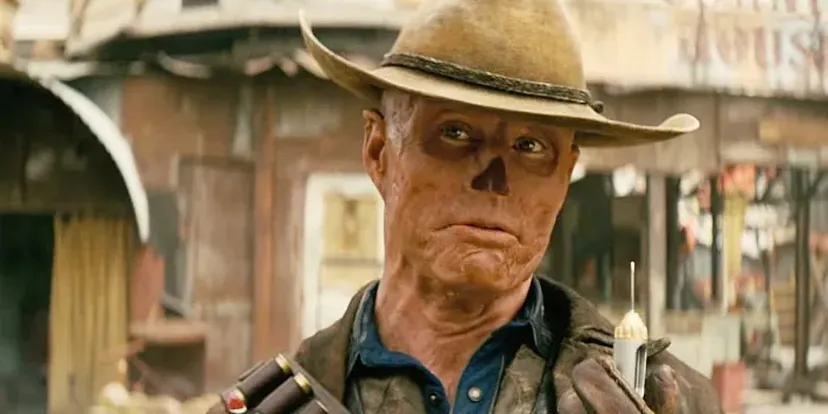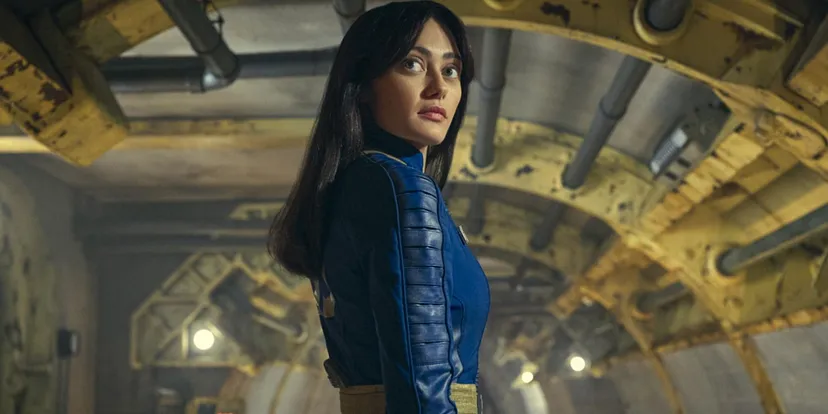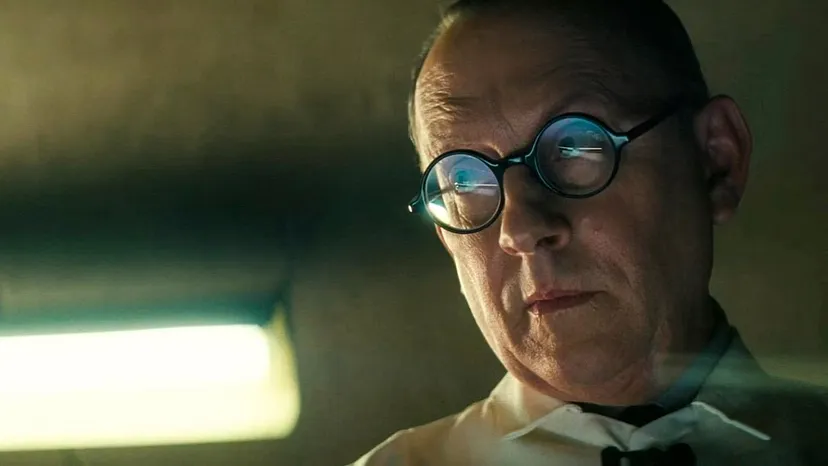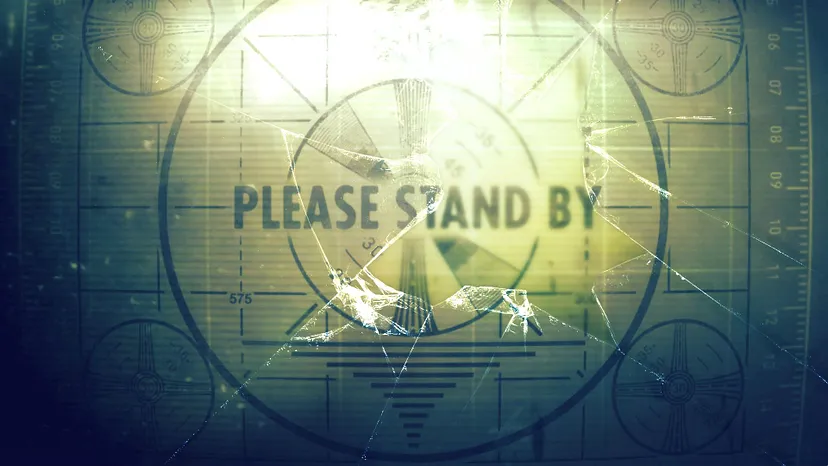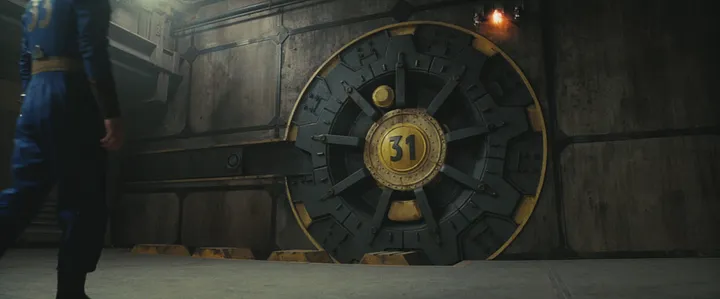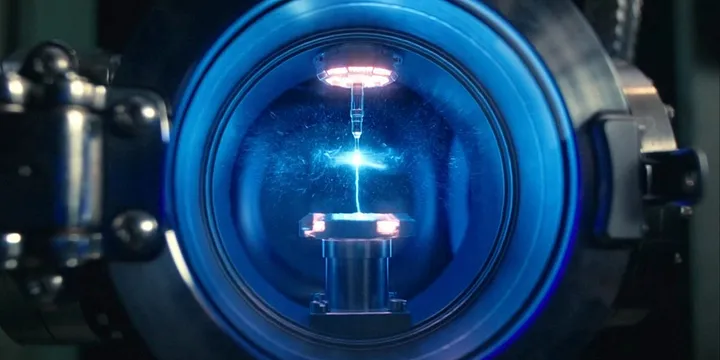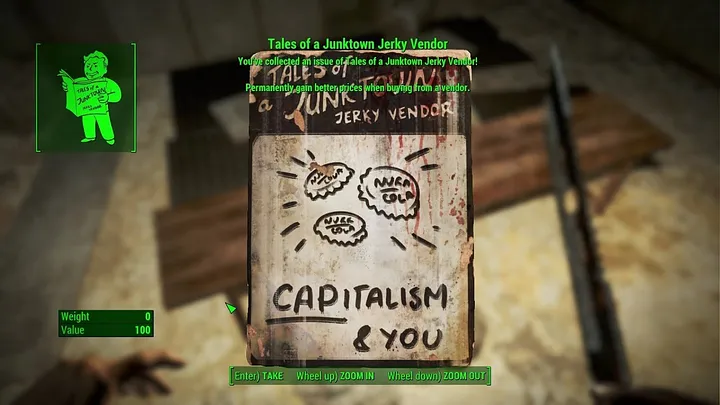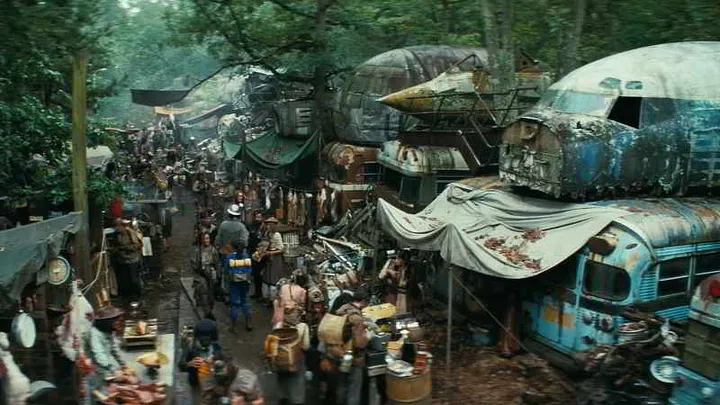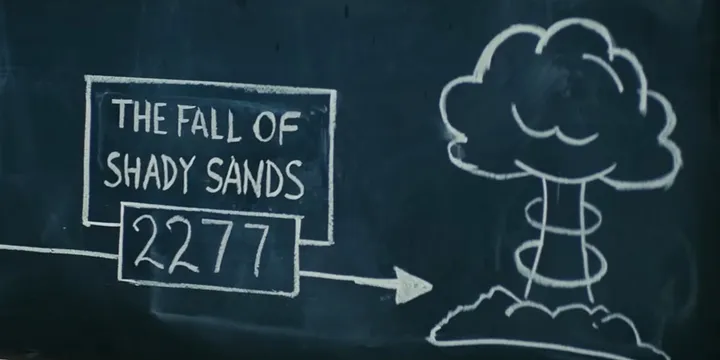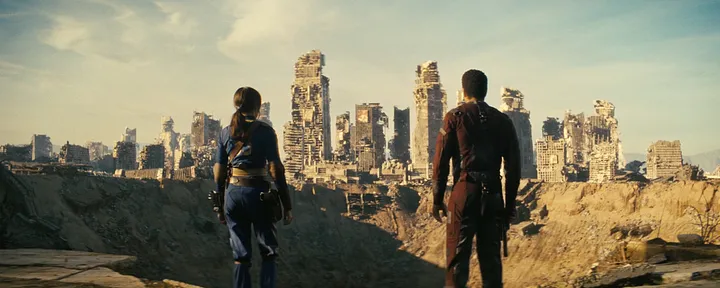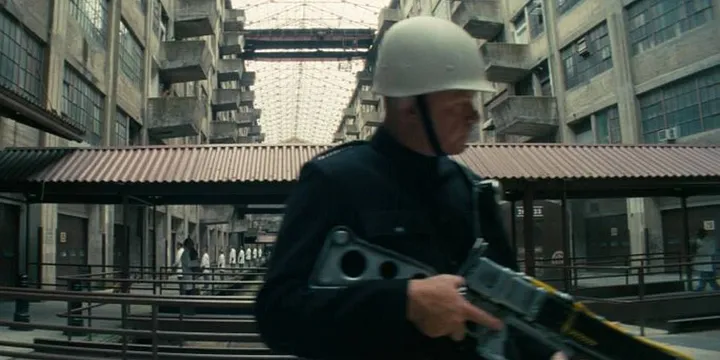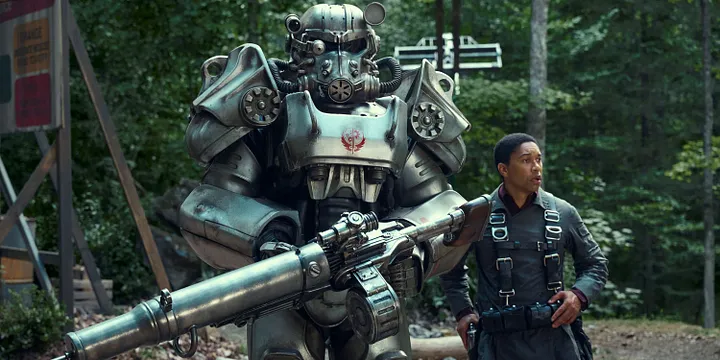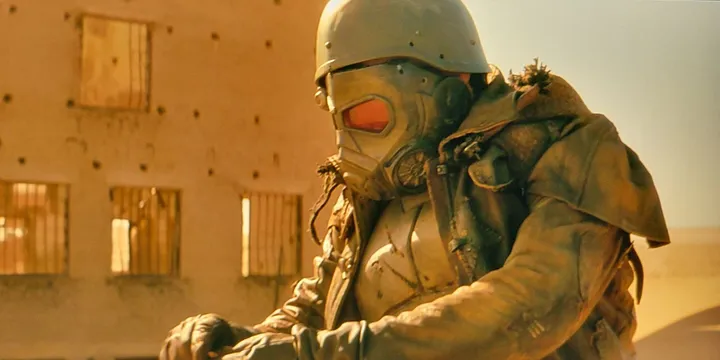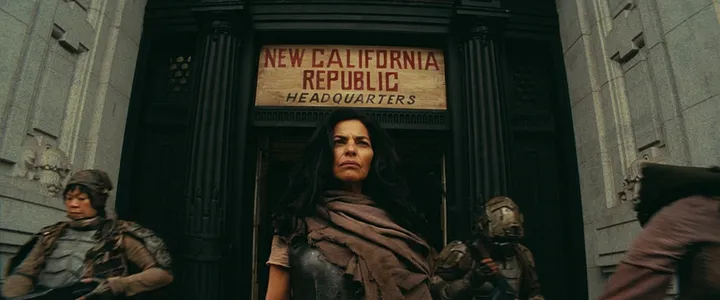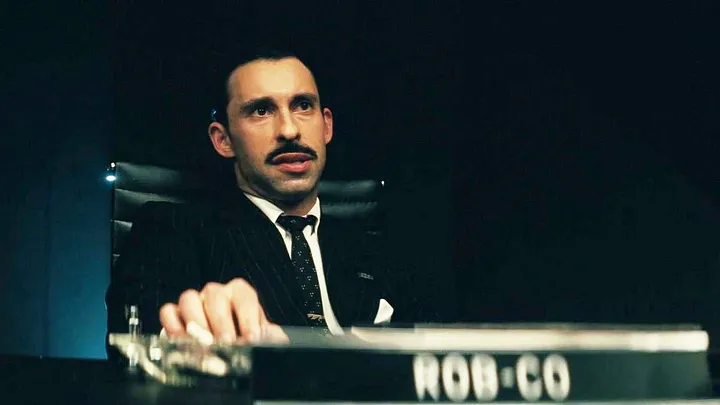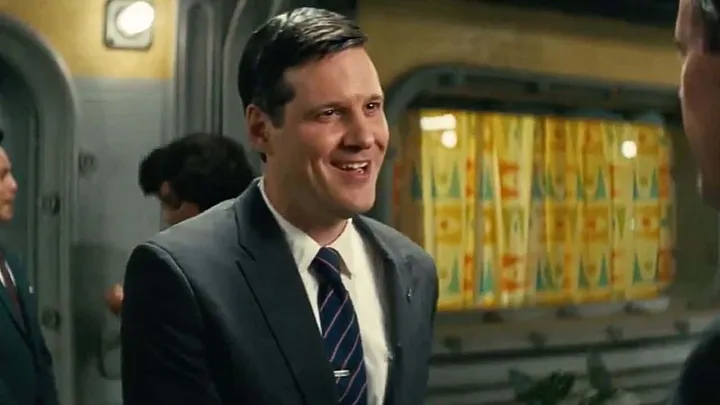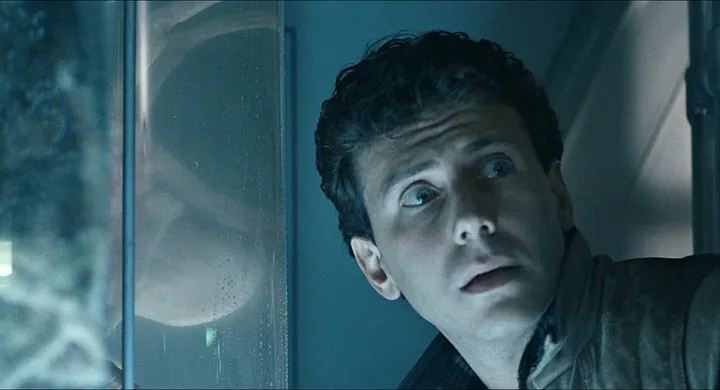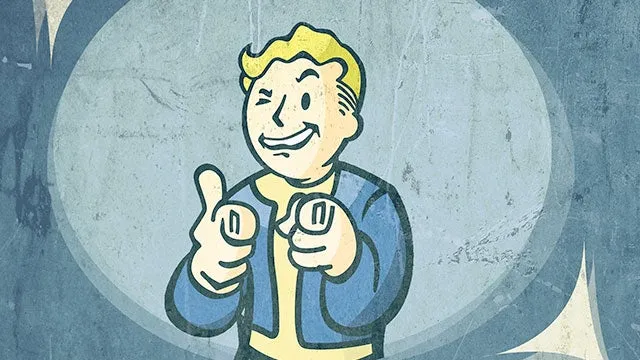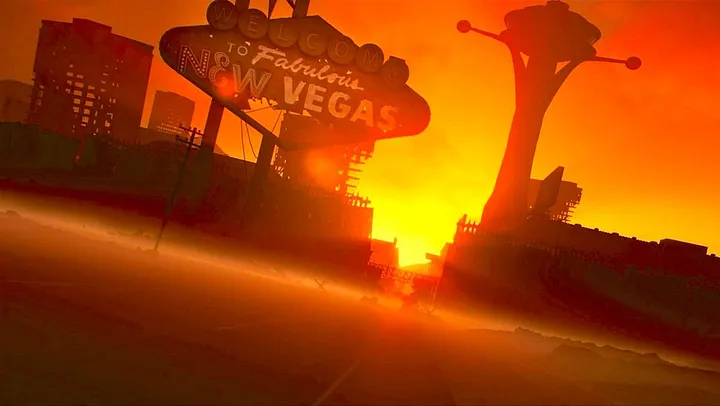Master Chris Avellone Thread
We should steal MCA from that putrid swamp and bring him here to post on his career and RPGs in general. Tell him we killed @Roguey, it might do the trick.
- rusty_shackleford
- Site Admin
- Posts: 11010
- Joined: Feb 2, '23
- Gender: Watermelon
- Contact:
I highly doubt him or Sawyer thought anything of the quest when it was added to the game, it's just typical leftist history revisionism they have to regularly perform to not get canceled.Shillitron wrote: ↑ April 26th, 2024, 22:21Faceless_Sentinel wrote: ↑ April 26th, 2024, 21:30I played New Vegas two times and the only "rape quests" I remember is this, but rape is only mentioned, so I ask you what "rape quests" means.Shillitron wrote: ↑ April 26th, 2024, 11:49He was whining on Codex about how Sawyers rape quest in New Vegas was disgusting and sexist...
Exactly that quest. MCA was infinitely butt hurt that Sawyer put that in the design doc for the quest. MCA said it was inappropriate for video games and triggering then started BAWWWing about how he has known women that were abused blahblahblah.
10 minutes later some random woman accused him of sexual harassment and essentially ruined his life and career - funny how the world works.
- Shillitron
- Turtle

- Posts: 1687
- Joined: Feb 6, '23
- Location: ADL Head Office
I'm split 50-50.rusty_shackleford wrote: ↑ April 27th, 2024, 10:09I highly doubt him or Sawyer thought anything of the quest when it was added to the game, it's just typical leftist history revisionism they have to regularly perform to not get canceled.
Context: MCA was pissed off with Obsidian, IIRC this was around the time he was having a falling out with Parker & Fergus.
Either:
A) In a "I hate how Obsidian is run" passive aggression he began stomping around the office whining and bitching constantly about everything and saw the rape quest as a opportunity to grand stand and cause more drama.
B) He didn't know or care at the time and then in an alcohol fueled rage on Codex decided to do exactly what you said - a buncha "oh now I hated this the whole time - look look Obsidian encourages rape, what a shitty place" gossip dump in a sort of last "fuck you" to Obsidian after exiting. (It's well known that many Obsidian employees lurk Codex so he was probably hoping they would read his thread)
I hope he posts here and gets @Shillitron confused with Infiny and goes on a long unhinged rant towards him!Irenaeus wrote: ↑ April 26th, 2024, 22:28We should steal MCA from that putrid swamp and bring him here to post on his career and RPGs in general. Tell him we killed @Roguey, it might do the trick.
- Shillitron
- Turtle

- Posts: 1687
- Joined: Feb 6, '23
- Location: ADL Head Office
I'm still butthurt that he called me a fake journalist.Acrux wrote: ↑ April 27th, 2024, 13:55I hope he posts here and gets @Shillitron confused with Infiny and goes on a long unhinged rant towards him!Irenaeus wrote: ↑ April 26th, 2024, 22:28We should steal MCA from that putrid swamp and bring him here to post on his career and RPGs in general. Tell him we killed @Roguey, it might do the trick.
Fun note on Jet for #Fallout. The idea for the inhaler as a delivery mechanism came from members of my family, me included, who had asthma when younger.
2ndCommunity Question on #FalloutOnPrime – while watching the show I was confused about the drug that kept The Ghoul from becoming feral. At first I thought it was regulated/diluted RadAway, then it seemed to be Jet, then… I have no idea. Is it said what this is?
My comment: I don't think anyone that made that show actually cares to adhere to anything coming from the first 2 Fallouts.
some urinalist says wrote:EA CEO says they have a 'real hunger' to start using generative AI 'as quickly as possible' on their games
"We believe that more than 50% of our development processes will be positively impacted"
MCA replies with wrote:"We can finally get rid of those troublesome employees."
"We can finally ship games in less than 8 years of dev time"
I'm legitimately amazed BioWare continues to exist given that the last time they made something relatively functional was ten years ago now with Inquisition - at this point replacing 3/4 of its development team with fucking AI might be the only way to save Mass Effect and Dragon Age IPs from permanent death (especially when Dreadwolf flops and development hell gets blamed for it).
EA murdered some of its studios for far less.
EA murdered some of its studios for far less.
I wish he posted more on 2017 Prey. I really liked the game.
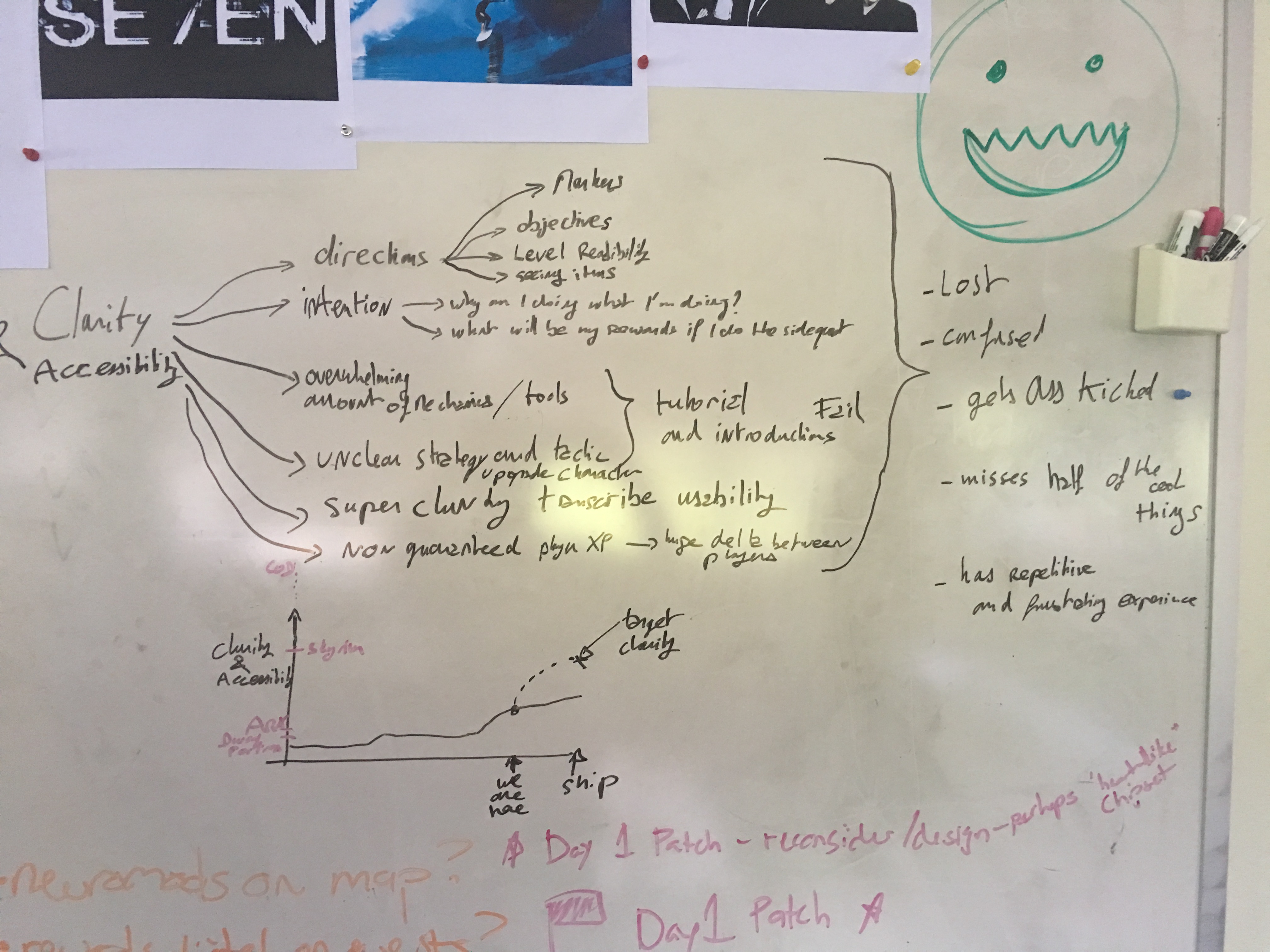
Old picture on my Iphone of a meeting with @RicardoBare during the Beta of #Prey. We assessed that the game sucked in term of accessibility/fun/clarity, so we scrambled to take decisions on how to course correct. Proof that gamedev is hard... Also sorry for the bad hand writing

LOL we literally had a Pagan faction *Daughters of Hecate" in Fallout Van Buren you could join, do quests for, and potentially lead.
- destinyhntr
- Posts: 66
- Joined: Apr 11, '24
Sam Witwer seems to have some great takes and actually knows the lore. I'd love to see him do more with itAcrux wrote: ↑ November 22nd, 2023, 03:46Filoni is the ONLY person since George Lucas that understands Star Wars. They are movies for children.
Oh no God forbid some of those true rockstars at companies like Bioware might get replaced. How will fat dykes and indian diverisity hires be able to put blue haired trannies who speak exclusively in marvel quips in their games nowThe_Mask wrote: ↑ May 9th, 2024, 22:09
some urinalist says wrote:EA CEO says they have a 'real hunger' to start using generative AI 'as quickly as possible' on their games
"We believe that more than 50% of our development processes will be positively impacted"MCA replies with wrote:"We can finally get rid of those troublesome employees."
Half of those poor innocent employees are the kind of people who fired him and immediately distanced themselves from him the second he got an allegation btw.
giga based. fire those fuckers.The_Mask wrote: ↑ May 9th, 2024, 22:09
some urinalist says wrote:EA CEO says they have a 'real hunger' to start using generative AI 'as quickly as possible' on their games
"We believe that more than 50% of our development processes will be positively impacted"MCA replies with wrote:"We can finally get rid of those troublesome employees."
Eh they're only slightly better than disney in that they write shitty fan-fiction tier stories (including obnoxious OCs that are forced into everything) instead of trying to write active subversions.destinyhntr wrote: ↑ May 17th, 2024, 05:40Sam Witwer seems to have some great takes and actually knows the lore. I'd love to see him do more with it
Apparently MCA has decided to follow Tim Cain and also sell himself for some cheap, false, temporary notoriety.
Why go down Maximus' path when you can spend bottlecaps to get your armor instead #Fallout #FalloutOnPrime
Is so sad that even after he was proven innocent, he will be kept canceled and "sweet babies" will be hired in his place...
Unfortunately he's basically been reduced to the same "Hey remember me? I'm the Fallout guy!" dustbin of history as Tim Cain.Anon wrote: ↑ May 17th, 2024, 17:15Apparently MCA has decided to follow Tim Cain and also sell himself for some cheap, false, temporary notoriety.
He was shitting on the show a couple of weeks ago. So, it's possible this was meant ironically.Anon wrote: ↑ May 17th, 2024, 17:15Apparently MCA has decided to follow Tim Cain and also sell himself for some cheap, false, temporary notoriety.
Why go down Maximus' path when you can spend bottlecaps to get your armor instead #Fallout #FalloutOnPrime
Or, maybe he's now a pathetic middle aged man who refuses to admit that his old friends have abandoned him and the next generation doesn't care about him.
- destinyhntr
- Posts: 66
- Joined: Apr 11, '24
If you're referring to Filoni, I agree. He did have some good stuff in the Clone Wars but you had to wade through a lot of meh stuff (and straight up fanfiction) to find it. But I was referring to one of the actors, who has been working for George since before Filoni and Star Wars. He was one of the only actors to call out how horrendously they treated Luke Skywalker (saying what Mark Hamill was scared to say).Vergil wrote: ↑ May 17th, 2024, 05:56Eh they're only slightly better than disney in that they write shitty fan-fiction tier stories (including obnoxious OCs that are forced into everything) instead of trying to write active subversions.destinyhntr wrote: ↑ May 17th, 2024, 05:40Sam Witwer seems to have some great takes and actually knows the lore. I'd love to see him do more with it
Witwer is okay but I really don't care for how Darth Maul has been given this weird focus and over importance. That one book that had him come back and fight Obi Wan was cool. Now the fucker shows up in EVERYTHING.destinyhntr wrote: ↑ May 17th, 2024, 19:35If you're referring to Filoni, I agree. He did have some good stuff in the Clone Wars but you had to wade through a lot of meh stuff (and straight up fanfiction) to find it. But I was referring to one of the actors, who has been working for George since before Filoni and Star Wars. He was one of the only actors to call out how horrendously they treated Luke Skywalker (saying what Mark Hamill was scared to say).Vergil wrote: ↑ May 17th, 2024, 05:56Eh they're only slightly better than disney in that they write shitty fan-fiction tier stories (including obnoxious OCs that are forced into everything) instead of trying to write active subversions.destinyhntr wrote: ↑ May 17th, 2024, 05:40Sam Witwer seems to have some great takes and actually knows the lore. I'd love to see him do more with it
- destinyhntr
- Posts: 66
- Joined: Apr 11, '24
I agree with you there. The Clone Wars did make him one of my favorite characters but beyond the Clone Wars arc, I didn't particularly like what they did with him. Should have let him have his moment, then moved on.Vergil wrote: ↑ May 17th, 2024, 19:37Witwer is okay but I really don't care for how Darth Maul has been given this weird focus and over importance. That one book that had him come back and fight Obi Wan was cool. Now the fucker shows up in EVERYTHING.destinyhntr wrote: ↑ May 17th, 2024, 19:35If you're referring to Filoni, I agree. He did have some good stuff in the Clone Wars but you had to wade through a lot of meh stuff (and straight up fanfiction) to find it. But I was referring to one of the actors, who has been working for George since before Filoni and Star Wars. He was one of the only actors to call out how horrendously they treated Luke Skywalker (saying what Mark Hamill was scared to say).Vergil wrote: ↑ May 17th, 2024, 05:56
Eh they're only slightly better than disney in that they write shitty fan-fiction tier stories (including obnoxious OCs that are forced into everything) instead of trying to write active subversions.
OMGosh U Guyz! Sam Witwer is ONE OF USSSSS!!!!!!!!!!!!
1. Formatting is not perfect, because I don't have the patience.
2. His opinions are his own.
3. His writing is his own, down to the usage of smileys, too.
4. MCA needs to move to a right wing state. The situation is pretty sad.
5. That being said I'd still recommend going on his web page to give him the clicks, but everything is pasted here in case you're lazy.
2. His opinions are his own.
3. His writing is his own, down to the usage of smileys, too.
4. MCA needs to move to a right wing state. The situation is pretty sad.
5. That being said I'd still recommend going on his web page to give him the clicks, but everything is pasted here in case you're lazy.
Welcome!
This is a special version of the Fallout Apocrypha. It breaks down the Fallout TV series on Amazon Prime.
This first installment lays out a foundation for the review and examines the characters and their arcs. The second installment (in a day or two, also here) will break down the lore in the series.
The “Fallout Apocrypha” is a continuation of the Fallout Bible, and you can find installments in my Medium gallery if you want to review any of it — it may help answer feelings on Bethesda (no, I don’t hate them, nobody I know on Fallout New Vegas does), my critiques of Bethesda’s previous Fallouts, and other Fallout information.
Also, there are plenty of other reviews of the series on the net. I encourage you to check them out to get a range of perspectives.
Tim Cain, for example, one of the core creators of Fallout has a YouTube channel that’s worth checking out not just for Fallout, but for a whole range of development advice — you can find it here: CainOnGames
Obviously, this review has spoilers — but some of the feedback here won’t make sense unless you’ve watched the series, so…
…let’s get started!
Long ago when I was pitching games, I was told that James Cameron had an approach for pitching — rather than listening to a horrible droning PPT, he apparently asked to see what the movie poster for the film being pitched would be.
I thought this was genius, because a good movie poster is intended to encapsulate the qualities of the show and set viewer expectations at a glance. It’s like a game box cover in some respects. Do you want to experience the entertainment being shown?
That being said, the poster for the Fallout TV series is this:
…and it’s spot on, both good and bad.
What makes *you* qualified to write a review?
Good question. A few things:
I am not a Microsoft employee.¹
I once got an offer to work on F1 from Tim Cain, which I refused and still kick myself about to this day.²
I worked on Fallout 2 and Van Buren at Interplay, then Fallout New Vegas and most of the New Vegas DLCs after that.
Tim and I did “star” in Nuka-Break, the Fallout limited series, way back when. My appearance is especially egregious.
I wrote installments of the Fallout Bible and the Apocrypha here on Medium.
I have watched Memento and Westworld.
Probably like you, I like the Fallout franchise.
Lastly, I have no skin in this game. It can be very tempting to say “oh, you’re pandering, you’re a fan boy, you’re envious/bitter, you hate Bethesda,” blah blah.
But really? I don’t give a shit, and never would have watched the show (I didn’t care) or written this if people online hadn’t pinged me “blaming” me for the series’ choices which I never made. I’m more than happy to give a show praise when it’s deserved, and I do for some points below because there are some things I think the show does well.
So regardless of my lack of desire to see it, I gave it a chance. I watched it, took notes, watched it a second time with more notes, then sent a letter of congratulations to Todd — regardless of my opinion, it’s a huge achievement to see Fallout as an official series. It can’t have been cheap, and it can’t have been easy.
So kudos to them.
[1] BTW, if you are a Microsoft employee, it’s time to unionize.
[2] On the plus side, the writing for Fallout 1 went to Scott Bennie at Interplay instead, which was great because Scott was a great writer and added a lot of quality to Fallout. He also was the one who gave me my first home in California, and he will be missed.
“Hey, dummy, you missed something or got X, Y, Z wrong…”
…and if so, feel free to point it out — I’m sure there’s elements I missed. Even watching the series a second time, I still didn’t feel as if I gotten everything.
Why watch it twice? Well, because lore research is work, but it’s worthwhile work.
I also did this because it would be hypocritical of me to be critiquing someone not putting in the work to research the lore if I don’t do the same.
Reasons to Discount This Review
Let me do some work out there for the naysayers who want easy excuses to discount this review:
1. I did not play Fallout 4 extensively beyond 1 hour of the opening and watching 2 of the endings before deciding I wouldn’t play any more of it. Any lore hooks shown in F4 (like Hancock turning into a ghoul overnight) I am blissfully unaware of.
2. I didn’t like the executive producer Johnathan Nolan’s previous work, Westworld, beyond Season 1. I have watched all the seasons, to my regret.
The mention of Westworld is especially apt, because Westworld is a fictional locale that feels real when you watch it, while Fallout is supposed to be in the real world but somehow feels incredibly fake throughout — and I’m curious what would have happened if they’d applied the real world sensibility to some locales, people, and scenes — the birthday party at the outset comes close, and it’s a great scene, but that’s about it. Instead, everything feels… sugary.
I also am genuinely confused how someone who penned one of my favorite movies, Memento, could abide the dialogue and pacing in this series.
I do feel that the Fallout series has the same problem Westworld does — there’s a lot of characters that no one seems to know what to do with. And it was very amusing to see connections between F4 and Westworld, now that I realized that Nolan and Howard were in touch. If you’ve seen the synth dunking chambers in both F4 and Westworld, you know what I mean.
Westworld Top, F4 Bottom.
If you love Westworld in its entirety and feel it’s the most amazing piece of cinema ever, then you will find very little to like in the following review.
3. In many ways (start lighting torches, pitchforks come later), this whole series reminded me of the final season of Star Trek’s Picard.
If you haven’t seen it, Season 3 of Picard is a masterclass in fan service, gives the audience arguably everything they’ve ever wanted, and is wildly entertaining.
It is also a largely terrible, random story that had me smh repeatedly. The craftsmanship outside of fan service moments felt non-existent and non-cohesive.
If you think Picard S3 was the best, narratively solid thing you ever saw in this universe or any other, then you can stop reading this review right now because you’re not going to like my takes.
4. Annnnnd the last reason to discount this review is because we’re both entitled to an opinion. If you like something, you like it. You can’t argue with that. I can’t argue with that, and I wouldn’t — the way you feel about something is one of the most honest emotions you can have.
And if I like something, I like it, and that’s fine — because it’s fine for both of us to have an opinion.
So read on!
Entertaining and Craftsmanship
I have two categories when evaluating movies: Entertainment and Craftsmanship (Quality).
The reason for this is there are bad movies I love even though I know they are bad (Resident Evil 1), and there are good movies I don’t enjoy watching, even if well-crafted (Natural Born Killers).³
It also applies to more modern sci-fi — I’d argue that Silo and Foundation are much higher quality shows, but they didn’t carry the same raw entertainment value that Fallout does.
So how does Entertaining vs. Craftsmanship play out in Fallout?
Was Fallout entertaining?
Yes.
The Fallout series is an entertaining spectacle that works well as a trailer for the current state of the Fallout franchise.
This is important because there’s nothing angrier than a player with a false expectation, and as such, the Fallout TV series is an appropriate on-ramp to the current state of Fallout with little to disappoint those who have only the show as a tutorial.
This means if you watch the series and play Fallout 4 or 76, chances are, you’ll feel right at home.
I’d argue if the series felt like a more serious Fallout 1 story, then you tried to play Fallout 4, you wouldn’t be very happy and would be like, “what the hell is this?” (This is one of the reasons why I don’t play F4 or 76.)
On Craftsmanship — is Fallout a good, thoughtful, well-paced series whose plot respects its own internal lore, its own dramatic payoffs, and uses foreshadowing effectively cinematically and narratively?
Nope.
I’ll address some of the biggest examples later. I didn’t even bother with most F1 and F2 contrasts because that was too easy (we already know there’s leagues of difference there just from the proximity of the new vaults’ placement to the original vaults, origin of ghouls, etc.) and unfortunately, those contrasts are not important. I know that me saying that will likely anger those who love the originals, but it’s true — those Fallouts are gone.
Instead, I believe it’s a more valid comparison to drill down on how the show tried to craft its own internal lore, and see how their attempts succeeded and failed.
The big ones I’ll address later on in Part 2 of the Review are the Vaults, the nature of Ghouls, the literal Power infrastructure in the wasteland, and some major themes like capitalism (which was never part of the original Fallout premise despite what you may think — capitalism equaling evil is a very modern shout topic, and it’s not surprising that Hollywood leans on that for a big reveal).
Again, this doesn’t mean I didn’t enjoy watching it. I like watching a lot of bad shows and movies and there are some I could watch repeatedly and never get tired of it. While Fallout doesn’t quite hit this level, it’s definitely more entertaining than good.
Did the show feel uneven?
Yes.
I didn’t have a problem with this except that it called attention to scenes that felt like a waste of time vs. could have been answering lore problems/showing more of the foundation of the world.
While The Ghoul calls out the irritation of being sidetracked in one scene and you can hyuk-hyuk about him complaining about side quests, the issue is the writers have more control over a TV plot than a game plot, so they should use it, not embrace the game’s chaos. I mean, use every episode in a quality manner, that’s not so hard. Keep the pace consistent, keep the focus going where it needs to — that’s where TV shines, you can literally force the viewer to only look at what you want to see, unlike a video game.
My feeling was, starting with Episode 5, things started going downhill and the problems grew. I think this is natural because the opening episodes focused more on immediate predicaments, but as the series and world opens up and the full motivations for the cast become more apparent, the larger questions start showing up, and those don’t have good answers.
Now, I’m going to talk a little about lore, retcons, and older Fallouts vs. the series, and these don’t have good answers, either — and may be answers you don’t want to hear.
[3] I call bad movies I find entertaining “popcorn movies” because I can watch them anytime, anywhere, and still enjoy them even as bad as they are. You probably have a list, too, but I think we’d be the same in that we would never recommend these movies to anyone as cinematic tours de force. The Fallout series doesn’t quite hit that bar of being infinitely rewatchable.
Lore and Retcons
My belief is, in a perfect world where designers do their research, retcons aren’t necessary.
If you’ve designed lore in the past, you often don’t need to retcon anything, you just need to explain more or find a way to “get to where you want the lore to go” from the previous roadmap.
It would have been easy to do with Jet. It would have been easy to do with any Fallout 1 or 2 lore point vs. simply ignoring it.
I do think if Bethesda did embrace this practice, they’d do a lot to reduce some frustration from players, but it does require research and work to do properly — and I admit, doing that level of research isn’t fun (this is coming from the guy who absorbed everything he could about Star Wars for Knights of the Old Republic II, including the Star Wars Christmas Special), but the rewards pay off for both the developer and the player. It makes the player’s experience in previous games more valued vs. discounted.
So now for a question you may be surprised to hear me ask…
*Were* the older Fallouts better?
For those of you who swear by the older Fallouts, I did want to address some potential horse blinder aspects of “oh wow, the older Fallouts were so much better.”
I mean Fallout 1 was. It was pretty damn good. And that voice cast! Dammmmn.
However, Fallout 2 and what followed — the console game Brotherhood of Steel — weren’t as good. I’d argue they hurt the franchise more than people “blame” Fallout 3, 4, and 76 for doing.
This is important to point out because I think there’s some kind of illusion out there that Fallout at Interplay was going amazingly well and keeping the franchise “on track”.
It absolutely wasn’t, and it was definitely experiencing the same lore breaks and inconsistencies that fans bring up about more recent Fallouts.
Everything back then wasn’t rosy, I just think sometimes people think it was. So I did want to point that out for the sake of contrast — there’s nothing to prove that had Interplay kept going with Fallout (even Van Buren) that things would have been awesome in the world of Fallout.
In fact, if Bethesda hadn’t bought Fallout, I seriously doubt there would have been another Fallout, let alone at the scale of F3, F4, spinoffs, T-shirts at Target, and the TV series. While it’s easy to give that stuff the finger, it’s testament that a franchise in the right marketing hands can grow to something none of us would have expected… because at the last stages of Interplay, there was no confidence that that level of popularity would ever happen vs. the company going out of business.
Does the series embody the core narratives of the early Fallouts?
Ignoring the broken water chip nod, which was mostly confusing and embarrassing, what I’m referring to here is the core narrative theme of Fallout 1 — not the water chip, not the fight against the Master, but the idea that after your player character’s constant sacrifices, including risking your life to save Vault 13, it turns out the very ones you fought to save — the Vault Dwellers — decide that you’ve changed too much to return to life in the Vault, and they cast you out.
After all you’ve done, and all you’ve risked… you can’t go home again.
This concept is embodied by the Vault Dweller walking off into the wastes at the end of Fallout 1. It’s essentially the bittersweet “you can’t go home again” narrative. For many, me included, that was one of the most powerful moments in the game, and it hit even harder than defeating the Master.
Now, does the TV series come close in showing change in characters that may cause them to be ostracized by their own later on? (Lucy obviously being the most important one, although Norman factors in.)
So far, easily yes. Lucy, the Ghoul, Maximus have all changed by the end of the series — for Lucy and Maximus, it’s the question of acceptance within their faction. Even minor characters, like Norman and Bert… er, Chet, go through considerable changes.
Lucy definitely has changed compared to most of her Vault, and certainly enough to be eventually cast out… but read my minor point below (I’ll include any minor quibbles or notes at the end of each header, but recognize they are minor points).
Minor Point: Going beyond the points above and speculating for the future, I also argue that in Lucy’s case, for the “Fallout 1 narrative” to work (Vault Dweller no longer being accepted home) this would require Norman being alive by the end or this story can’t work.
The reason only Norman’s opinion matters is because everyone else in the Vaults is a clown, an idiot, or a bad guy whose opinion no viewer would care about. You wouldn’t care if the other Vault dwellers, Betty, Stephanie, Chet, or Woody cast you out because they aren’t people you respect or even on your side.
However, with Norman being the brother of Lucy and being the only one in 33 who seems to be proactive, he’s the only one that plot point could effectively play off of. If you don’t understand this, ping me online and I’ll try and explain it better.
Does the series embody the core narratives of later Fallouts (3, 4)?
Yep, as soon as Lucy says, “I need to find my Dad.” Which has been the plot of most of the Bethesda Fallouts, so… yeah.
:: Wherre oh where has my evil Dad gone, where oh where can he beee ::
Todd/Emil, please change the record, we get it. You miss your families. But does it have to be everybody’s problem?⁴
For the record, we used to have a similar trope at Black Isle which was “get killed, wake up from the dead,” which did make it into FNV, so we had our share of tired tropes, too, so don’t think I’m getting on my high horse here (or high Brahmin).
Now that we’ve covered all the history and comparisons to the games, let’s dig into the craftsmanship of the show.
[4] Am teasing. Uh, I hope.
Music
So just to get it out of the way, the music’s great and very much in keeping with Fallout.
Even better, the lyrics emphasize what’s transpiring in the scene, and that’s pretty classy.
Bravo, 10/10.
Violence/Gore
This show is very violent and gory, and that’s true to the old Fallouts, and I was surprised by how much they leaned into it.
Granted, there were parts I thought were unnecessary and sometimes didn’t make sense except for deus ex machina. As an example, Wilzig’s robot leg that simultaneously kills him felt unnecessarily gory in a way that made it seem implausible but worked for the not-quite-so-interesting choice of removing Wilzig’s character. #JusticeForWilzig
CHARACTERS!
The Ghoul (Walton Goggins)
Thought Cooper Howard/The Ghoul came out the best, although he has a bunch of wasted scenes that seem to be him in a room, threats in the room are traded, then he kills either some or all people in that room. Rinse and repeat.
Walton Goggins I like a lot as an actor, and I was worried he would be sidelined or given a shallow role in the series. The series surprised me by making him part of the foundation of the rise of Vault-Tec. This was done in a way that felt plausible to me, emphasized the struggle going on in the world at the time, and also the internal struggle that Cooper was going through — the whole theme of being “big, ugly, and having dignity” is the challenge that The Ghoul faces. It’s all tied back to when Cooper’s character felt beholden to a movie script and shot an unarmed villain as he lay in the dirt — all that was great, imo, and I thought they did that well.⁵
This was one of the good things about the Super Duper Mart encounter — I liked the callbacks for the dignity check for The Ghoul and then seeing on the TV the very movie where he was first depicted as a “murderer” and not true to himself — it feels like Cooper’s remembering who he used to be while watching the TV show, which is great, and this happens without a word. Perfect.
On a minor note, calling someone “the ghoul” in a world of ghouls in a non-ironic way is problematic.
The ghoul drug/feral problems have been discussed online already and I’ll also cover it more extensively in Part 2, since it’s a mess. Right now, I’ll point to all the problems that make this worse tied to the Ghoul specifically:
- The Ghoul is a Chem Fiend (on his actual character sheet), so I’m guessing this is why he ingests every drug he can find. There are two problems with this — one, it ends up confusing the anti-feral drug he consumes as it’s hard to isolate that it’s THAT drug that’s keeping him sane vs. other drugs. The second thing is the presence of all these drugs in his system makes me wonder, well, if Lucy’s tranq dart won’t work on him (Ep 2), why would an anti-feral drug if he’s such a “huge bucket of drugs”?
- And more explicitly, the questions above don’t even work with the Chem Fiend Perk — that perk makes the duration of drugs last longer vs. what’s displayed in the show, which implies his body is more accepting of drugs, not fighting them like with the tranq dart.⁶
- The fact he’s a Cannibal, too, also confused the issue about the feral drug issue (other people online were speculating that by him consuming other ghouls he got more sane because they might have anti-feral serum in their flesh? But… Robert was feral, right?). Overall, this doesn’t work.
- The idea that there’s a drug that turns people into ghouls in less than 15 minutes and heals all their wounds feels out of place and definitely doesn’t mesh with F1 and F2. This isn’t the show’s fault.
- The Ghoul suddenly revealing that the Power Armor has a flaw that guarantees insta-kills is problematic based on the gunfight in episode 2. The fact he didn’t exploit the armor’s weakness when Maximus seemed to have the upper hand in Episode 2’s shoot out was… confusing in retrospect. There wasn’t really any explanation for why not use his knowledge there vs. later beyond crafting a dramatic moment in episode 8— at which point, most watchers aren’t going to remember episode 2 unless like me, you rewatch the series and questions come up.⁷
Minor point: Also, speaking of that fight, Maximus getting his superpowered leg stuck in floorboards felt flimsy as fuck — I was almost embarrassed for the choreographer because it didn’t sell it with the scene and props.
On a positive note related to the Ghoul — while rewatching the series, I did like the callbacks to chickens that seemed to permeate the series — as an example with Cooper and his wife in the hot tub, and Cooper saying how much he’d like chickens on the ranch in Bakersfield (then remembering chickens were a feral ghoul test). It’s also a nice callback because Vault 12 in Fallout 1 was in Bakersfield, and that was where ghouls first appeared. : ) I hope that was intentional.
[5] I’m biased about Goggins because we got to work with him on Prey, and that was a blast. Many thanks to Raphael Colantonio for pushing for my involvement, I loved working on Prey.
[6] And before you say, “well, the tranq dart doesn’t work on The Ghoul because he’s a ghoul,” that’s not the explanation The Ghoul gives. He explicitly says the dart doesn’t work because there’s a huge amount of drugs in his system.
[7] It might be possible it’s the tempered lining, but if so, you need to explicitly say that after the bloodbath in Episode 10, which could have been fixed by the Ghoul saying a single line before slaughtering the soldiers, “always said tempered lining could have helped with that flaw — but you all didn’t think before you suited up, did you?”
Dogmeat
“Dogmeat,” (CX404) of all the characters, gets the short end of the stick.
She shows up intermittently in ways that don’t quite work, her backstory is confusing, and it’s harder because Michael Emerson (Wilzig, Enclave scientist) is soooooo good at playing manipulative, smart, and evil characters, it was very hard for me to shake that he genuinely cared about Dogmeat… which apparently he did.
I also couldn’t escape the fact that Emerson was ready to smuggle cold fusion out, but I wasn’t sure if he’d made actual plans for the dog to escape. He certainly didn’t have any plans established for escaping himself when push came to shove, which was weird if he was planning to flee the Enclave — I’d assume a smart scientist would have already have an escape plan in place as soon as he injected himself in the neck.⁸
Instead, everything Emerson was doing made me feel he was setting Dogmeat up for an experiment, not that they were bonding. I mean, he works at the Enclave, ffs.
After that, Dogmeat gets passed around, her name gets changed, she’s put in a Nuka Cola locker, and largely ignored.
Worse, they don’t focus on one of the best narrative ties between The Ghoul and Dogmeat based on Roosevelt (Cooper Howard’s former dog) and not allowing dogs into the vault — that could have all been strengthened in a positive way, but there felt like there was not enough follow through on that theme.
Disappointed, as are all dog lovers everywhere.
[8] In fact, seeing his escape plan play out after that would have been great for his character rather than his random chaotic fleeing.
Lucy (Ella Purnell)
Lucy was great, I thought Ella Purnell did a good job with a questionable script, and the earnestness of a Vault Dweller came through well.
There were a lot of moments I liked with Lucy, but one thing I especially liked is when The Ghoul is kicking the hell out of everyone in Filly in Episode 2, it only takes Lucy to look at the Vault Boy bobble head to remind her of her meritocracy vault and “doing the right thing” that causes her to intervene. I love seeing moments like that in shows because it’s unspoken, and it relies on the audience to draw the connection to give it meaning — and in this show, moments like this are a bit rare.
Also in Episode 2, the sequence where Lucy explains to Ma June about the purpose of the vaults I thought was great. It was a perfect example of the view of people who actually had to live and survive for 200+ years on the surface vs. a Vault Dweller suddenly showing up and preaching about how they’re coming to save everyone. The condescension of Lucy’s viewpoint in that scene, even if her character doesn’t mean to, was well done — the unintended arrogance of the Vault dwellers comes across as painful, and I appreciated that theme being exposed there.
Minor Points: (Again, these “minor” points are very, very minor). One thing that bothered me: Lucy certainly didn’t seem dumb — so I didn’t understand why Lucy started tracking the bad guys from Vault 33 when they clearly left from Vault 32, the entrance of which can’t have been far — and the Vaults certainly weren’t disguising their presence.⁹
I liked the fact that Lucy didn’t know how to knife fight, and she found holding the raider’s knife as a weapon strange in Episode 1. I love little touches like that.
[9] The fact the Vaults are so exposed and easy to find also didn’t feel appropriate for the series, more on this later.
Maximus (Aaron Moten)
Maximus’ behavior and the reasons for it were so confusing for much of the series, I found I couldn’t dig much into Maximus beyond a giant “?”
There’s a type of acting called “facial acting” that I don’t think Maximus is very good at or was given poor direction for, and it would have helped in a lot of critical scenes. (Norman also has moments where it’s not clear what he’s reacting to or why, so it’s not just Maximus.)
As an example, I honestly can’t tell if Maximus is happy or drugged during his sequence in Vault 4 — it turns out, he’s just happy to having the modern trappings of an actual “home”, but with the whole sinister mystery of Vault 4, kind of clouds the issue. This becomes worse when you’re trying to read his expression when he’s being questioned about murder or other crimes.
I will say that after becoming aware of truths while first watching the show, then rewatching it with the knowledge of what Maximus had/hadn’t done, it made his characters and his motivations less cloudy, which I think the show could have benefited from setting up better.
It was good that Maximus has a tie back to Shady Sands, but the Brotherhood angle there (the soldier who saves him) confuses that. Was it the Brotherhood who did it somehow at Hank’s urging? That doesn’t seem to fit. Or did the Brotherhood come after? Confusing, and some clarity there would have been nice.
I did think that the conflicts Maximus faced were exactly the difficult moral decisions you may have to make in the wasteland. The awful choice Maximus faces with Knight Titus was a good one — you do a very bad thing for arguably a very good reason (kill a dickhead who hates you to prevent being executed).
I did get an alternate take on the Titus scene from a Microsoft employee who (correctly) pointed out that the script for this feels really forced. It’s basically hammering you over the head to make sure you realize that Maximus has no choice, to the point of having Knight Titus repeatedly threaten Maximus just in case the audience doesn’t “get it”. So in that respect the craftsmanship of the dialogue is poor (I can see that perspective) and the staging of the scene feels a little less convincing. I still appreciated the choice Maximus faced, though.
Also, the fact Maximus had to choose between eating popcorn and saving Lucy in Vault 4 was one of the low points for his character and the series.
Minor Point: It was hilarious to see Titus running from the Bear.
Wilzig (Michael Emerson)
Not enough was provided to give context to his character in the series, I wish he’d been in it more. I did find myself fighting against typecasting Emerson’s normal roles to Wilzig,¹⁰ and then having to question the assumptions there in relation to his motivations.
Michael Emerson and Lucy’s first scene around the campfire I thought was a great setup for bookending the themes of the series — I thought it was great for what was to come in Season 1 and what might come later in Season 2. Emerson largely carries that scene, so I’m mentioning it in his section vs. Lucy’s.
Minor Point: Wilzig cannot be a very good scientist if he sees hazardous waste barrels and concludes that now is the right time to stop and plant his ass square on top of it (Ep 2). Or maybe he has low Perception, but I doubt it.
[10] To explain, in both Lost and Evil, Emerson plays a highly intelligent manipulator antagonist, and he does it damn well. As such, it was hard to ignore those acting chops/roles since the Fallout series was still leveraging 90% of this same demeanor and then added 10% “I care about dogs” and “there might be a morally good (?) reason why I’m smuggling cold fusion out.” (Which isn’t answered at all.)
Other Cast Members
Actors like Chris Parnell don’t deserve to suffer for a bad script. Chris Parnell is very, very funny, but the script didn’t help him here.
I loved seeing Matt Berry physically present in the series as a voice actor in Hollywood, and thought he was great as the voice for Mr. Handy. I also liked seeing him outside of just voice acting to have a scene with Goggins at the Vault-Tec party in the TV series.
Next: Lore, Stay Tuned!
So these are the reviews of characters, in Part 2, I’ll focus on the internal lore inconsistencies. I’ll post it here in the next day or two.
The score? That I’m going to leave until the very end, mostly because if a score is given too soon, sometimes no one stops to dissect the reasons for the score, and they may be reasons you don’t agree with.
Again, if you see anything I missed or facts got wrong, feel free to comment on it here, social media, or wherever — there may be stuff I missed, and I’m happy to course correct if a viewer saw something I didn’t. What I’d like to avoid, however, is anything that’s a speculative answer (“Well, what I imagined was…”) or “well, they’ll probably solve it in Season 2,” because I heard those two refrains waaaaay too often when asking questions about the series earlier.
See you soon, and thanks for reading.
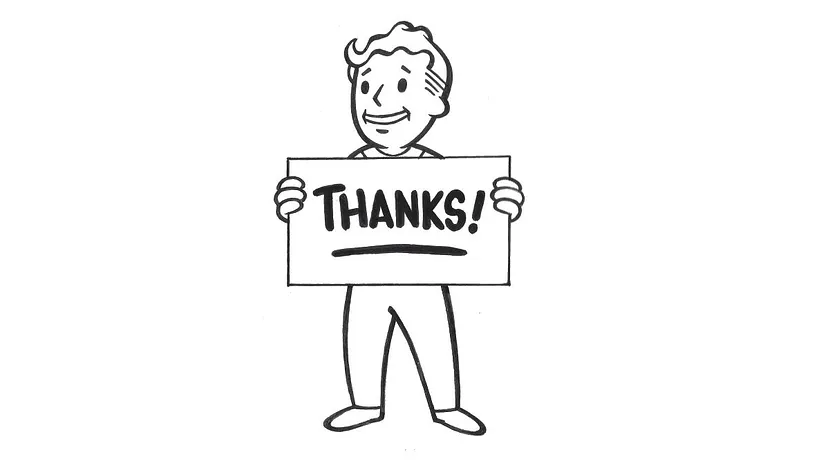
- Oyster Sauce
- Turtle

- Posts: 2345
- Joined: Jun 2, '23
He should spend more time sending out resumes and less time reviewing uninteresting TV shows
I have to admit that I like it when MCA swears like this. 
Seeing him talking aggresive like this i think hey may have been retired at this point
Part 2 of my review of the #FalloutSeries on Prime is up.
It focuses on the Fallout series’ internal lore, factions, and (sigh) antagonists. Buckle up!
This installment of the Fallout series review focuses on the series’ lore. As said previously in Part 1, this breakdown is not a comparison of all the differences between early Fallouts vs. the TV show (there’s tons), but instead, it judges the series on how it portrays and explains its own internal lore.
After that, I’ll go into the some of the other challenges I had with the series — the factions, the antagonists, and of course, the ultimate fate of Shady Sands and the NCR.
Inconsistent Lore: The Vaults!
So originally, vaults were intended as tests for space travel and Vault-Tec had won the bid to construct the vaults because they were the lowest bidder.
In the series, the Vaults become something less in an attempt to introduce more drama — when in fact, each Vault is supposed to have its own built-in drama from whatever experiment is going on at the Vault. That’s what makes them Vaults.
So one of the pillars is “life in the Vault.” This is largely fine in the series, except for a few things:
1. It is very hard to determine what Lucy’s Vault’s experiment was. While it may seem easy to explain this away as “well, it’s one of the good vaults so there was no awful experiment, just the meritocracy” that really doesn’t solve it, because it’s not: it’s a staged breeding program for super managers that is not hinted at throughout much of the series and falls flat when revealed —partly because that breeding program clearly isn’t working based on 99% of the Vault 33 Dwellers you see in the show.
2. It may not have been clear, but at no point do you see the entrance to Vault 31 in the “cornfield” early in the episodes (and posters suggesting the triangle of vaults don’t mysteriously show up till later).
When that entrance is finally shown in a cornfield (was this another one?), it’s not clear where that entrance was — if you notice in episode 1, there’s plenty of signs for 32 and 33 pointing the way, but nothing for 31 until much later. If someone else spotted it, let me know.
3. I was among some who thought that Vault 33 lost the fight with the Raiders in Episode 1, so I was surprised when the Vault apparently won.
Why did I think this? The reason is because almost every single scene up to that point showed the Vault Dwellers getting their asses handed to them (with some exceptions). Nothing that happened during that fight made me think 33 won the day, so I was like, “uh, what?”
Also, the “hostage situation” with Moldaver’s choice at the end of Episode 1 ended up being a letdown — because the choice Moldaver offers is a fake one, so it led to another “huh” and made me lose respect for her as an adversary, because she’s not hardline enough to keep her word when she’s giving a dangerous choice.
This plot decision also undermines a lot of similar hard choices in the future for the writing, which sets a bad precedent especially for an antagonist with any level of conviction to their cause like Moldaver supposedly has — we’ll get to some general problems with the antagonists later on.
3. The “triangle” vault of 31–32–33 is explained (eventually) as a unique set up, which is good, as obviously, most Vaults aren’t ever laid out like this because of the logistic disruptions (for the experiments).
For the TV series, the triangle DOES work for solving a TV-specific problem — the immediacy of three vaults, with one being a threat, provides face-to-face drama to the Vault in several ways. I can’t discount this reason since it makes for better “TV” than monitoring of each Vault experiment from a distance.
Also, arguably, they needed to show how outsiders (even from other Vaults) could infect/trade with another Vault. This would have been difficult if they had adhered to the old structure.
Another problem with this is it also calls attention to how things were managed in other vaults and how experiments were tracked so that Vault-Tec stayed in control and always had “their” Overseer in place. How were the other vault experiments monitored and controlled? If it was decided at some point the experiments in other vaults were done remotely and monitored remotely, that would have solved the immediacy of the need for Vault 31, imo.
Anyway, a larger point is the triangle-of-vaults method couldn’t have been used for the many hundreds of other vaults, so what was Bud’s solution for the other vaults? Was there one? It’s plausible there wasn’t, but who knows.
4. Was interesting to see that Vault-Tec had vaults in Canada and Mexico. My only problem with that is the Canadian vaults were likely too polite to partake in an experiment.
5. No idea why Moldaver doesn’t take the fusion core from Vault 33 if she “needs” power that badly. That at least would have foreshadowed events to come rather than leaving it to the 2nd half of the series, and would have helped on-ramp the power infrastructure theme that falls flat later on. It also would have added more pressure to elect a new Overseer.
6. I couldn’t wait for the embarrassment of Vault 4 to end. It was just too goofy and aside from the “We need Power” theme (which was done badly), the “plot payoffs” in this episode were painful. The idea that Chris Parnell descended from Gulpers is just… huh? Did he come out of one of their eggs? Was he cloned from one of their mouth-fingers? Sure!
7. I was a little surprised that so much was left to loot in V32 after the raiders supposedly went through it. I figured they would have taken everything, especially all the Pip Boys, and they would have needed the uniforms.
8. I mentioned earlier that the fact the Vaults are so exposed and easy to find also didn’t feel appropriate for the series, and felt like a conflict with the earlier Fallouts. The reason for this is plausibility — I can’t imagine that the wastelanders wouldn’t find a way to blast into these if they can find them, and hiding them would have been better (like Vault 13 in Fallout 1).
9. The Water Chip — anyone else go “huh?” over this when it was brought up in the series?
I don’t even have an explanation for why it was raised, why it was important, etc. As far as I can tell, it was a nod to Fallout 1, but it’s confusing because they don’t do anything with it.
It’s possible it was part of the “tragedy pressure” that allowed Betty to rise to power, but it’s not called out as such, it doesn’t feel like a stunt, and worse, it’s never really followed up on — plus, wouldn’t they have gone to V32 to see if they could use their water chip? That’s the whole premise that starts F1.
This may seem minor, but the point is, they didn’t need to put the water chip in — but they did, and it doesn’t go anywhere. More precious time wasted that could have been spent fixing other stuff.
Okay, but what did you *like* about the Vaults?
Loved the 3D projector and the pan showing the Vault layout and the levels — I liked the cornfield, too.
I also loved when the projector began to melt down, showcasing a nuclear-colored orange sky when the fight breaks out in Episode 1. It was a beautiful visual for the chaos taking place, and emphasized the show’s theme, too. Thumbs up.
I thought the slow build up to the ambush in Vault 33 was good in episode 1. I do feel like anyone, especially those from 31, would have sensed something was up. But that’s a minor point.
I liked the fact I found Stephanie increasingly dangerous vs. Betty’s level of quiet menace, so looking forward to her as an Overseer in Season 2. Poor Bert… er, Chet. I meant Chet.
Minor Points: I didn’t notice the Vault’s “chaplain” outfit until the second viewing, but I thought that was cool. It’s interesting they would allow religion in the vaults.
The library in V33 feels like it gets changed into a prison with antechamber and gates pretty fast (some of it feels like embedded construction, especially at the guard post).
Inconsistent Lore: Ghoul Pharma!
Can anyone tell me anything concrete about ghoul physiology? Anyone?
The whole serum that causes and prevents feral ghoul behavior was a mess. This is something that’s only cropped up in recent Fallouts but seriously, WTF.
For the record, the fact there’s a drug that when you drink it it heals all your wounds (except your nose) and restores broken bones back into their original shape within minutes is something that I probably wouldn’t drop into any game setting because its very nature causes problems.
It’s the ultimate military drug, frankly — why even have Jet? (Don’t get me started on Jet.)
But let’s look at why the serum’s presence and ghoul biology are especially shaky in this series, and why it’s made even messier through a number of poor decisions:
1. The Ghoul/Cooper says to Lucy. “I’m you, just give it time.” He doesn’t say, “I’m you, once you drink this magical serum that’s been going around.” If your response is, “well, that’s too obvious for him to say,” sorry, the whole series is obvious — and even if you don’t know the truth, this is one of those times in the lore where it’s better a character says nothing vs. giving a false impression on the origins of ghoul nature.
In short, if you’re going to indulge in scenes that are intended to spotlight bad lore, be clear about the bad lore — because when he says the actual line, the implication is that long exposure to radiation/wasteland causes the changes, which you then need to refute later on, wasting more time.
Edit: Please note that Lucy doesn’t ask The Ghoul who he is, she asks what he is. I also don’t believe she’s seen a ghoul or mutant up to this point, so her question seems more based on his physiology than his attitude. Besides, no person who watched The Ghoul shoot people would really question, “why are you acting like this? What drove you to this? Tell me your psychology.” No one cares. He’s shooting people.
2. The ghoul’s body is like a “bucket of drugs” so much so that Lucy’s tranq dart doesn’t work.
So… why does the anti-feral serum work? Why do any drugs work on him? Are the fact he takes all these drugs keep him from becoming feral? Who knows?!
I bring this up because in the responses on social media to why The Ghoul may not have gone feral, one explanation is, “he’s taking tons of drugs and they could be preventing him from going feral.” This isn’t a bad hypothetical, but the fact you can hypothesize about the wrong lore point and it makes sense, that’s bad. (See my point about “Vagueness Leads to the Dark Side,” later on.)
3. The serum has no name. This really helps! (Sarcasm)
The fact there’s a ghoul image on the serum vials (Ep 4) also made me roll my eyes — whether the label is pre-war or post-war, both cause problems.
4. The serum has multiple delivery mechanisms that work. While this isn’t implausible, in a fiction series, I wouldn’t confuse the issue more by varying the delivery of the drug — especially when one of the delivery mechanisms looks like he’s taking another drug (Jet).
So when Roger (the ghoul who goes feral in Ep 4) says, “I just need one little puff” I don’t immediately connect that to drinking the serum, but the inhaler method instead? More confusion.
5. The Ghoul ingests every drug and indulges in cannibalism. This is a problem because without a clear explanation for his Ghoul nature and the feral cause, a number of people online thought it was eating other ghoul flesh and ingesting tons of drugs was how he wasn’t going feral, which isn’t necessarily true.
Also, even more fun, you don’t even know that what’s really going on here — part of the reason behind his behavior is the Ghoul has “Chem Fiend” Perk and that’s why he’s doing it — but you wouldn’t know that unless you read his character sheet, so it’s just “huh”?
Overall, I wouldn’t care about this aspect and chalk it up to bad design, but it’s one of the Ghoul’s important pillars regarding his character. Fighting one’s feral nature is a very important theme of the series — but the lore and presentation supporting it is so bad, it’s difficult to puzzle out how the process works.
Minor Note: At the start of this section, I describe my reaction to the ghoul serum as “WTF.” If the explanation ends up being a different 3-letter acronym, however, then a lot of this stuff takes on a different light — but the lore construction for it and the roadmap that’s been used to get there is painful. If you don’t know what I’m talking about, here’s a clue: the 3-letter acronym I’m thinking of rhymes with “we’ll see.”
Inconsistent Lore: The Importance of POWER
Does this show drive home the lack of power and the importance of a faction’s control of it, making the cold fusion reveal incredibly dramatic in the final episode?
Nope.
Aside from the cartoon Benny Hill-music-themed-visit to Vault 4, there’s no indication that a lack of power in the wastes matters. There’s no indication that cold fusion is somehow better than fusion cores, but let’s say it is, and that restoring this power will be what ‘saves’ the wasteland… but how well was this framework constructed? How well was it foreshadowed?
I did think Moldaver and the shots of the Enclave should have done more to make this point about power and infrastructure more grounded and more important — I mean, was there the implication that the Enclave already had this limitless power if Wilzig stole it?
I did like Moldaver invented it (she never felt like she had enough screen time to matter, which is a shame), but the power sources in Fallout have always been a source of confusion.
At the end of the series, it doesn’t matter that the “NCR” gained it either, since the Brotherhood took it over after wiping them out as what feels like an afterthought.
So after all this effort, I’m not sure if Moldaver really wins anything in the end. That sucks. Sorry you showed up, Moldaver, better luck next time as a positive antagonist… and oh look, you’re bleeding out, silencing your character forever. Classy.
So basically, the asshole Brotherhood (more on this later) now owns a powered-up California and has apparently wiped out the NCR HQ in about, what, 30 minutes? Okay.
Minor Note: I was really surprised at the end when all those light bulbs still worked when the city lit up, but that’s a real-world critique.
Inconsistent Lore: The Evils of Capitalism
Was Fallout, as envisioned in Fallout 1, intended to be a powerful political statement about the evils of capitalism?
Nope.
How do I know?
Becase I went to the source and asked.
I thought there was a chance I was wrong, so rather than commit to an assumption, I decided to do some basic, easy research. Like asking a question vs. making a statement. It helps.
While there might be stories told by individuals and quests in Fallout that are anti-capitalism, to say its roots are anti-capitalist and Fallout was originally envisioned as anti-capitalist or an anti-capitalist statement is 100% wrong.
Now it’s fine if modern Fallout (3, 4, 76, the TV series) wants to embrace that theme as one of its pillars, but my point is that was not the original intention behind Fallout.
I don’t care if the modern games pick up that football and run with it, that’s fine.
Other Random Lore Bits
Some quick other notes on the lore, but not enough to merit sections of their own:
The Beginning
The birthday party scene gave me high hopes this level of craft would be the quality bar the show measured itself by. It was very well done, and it captured Goggins/Howard’s struggles in the past without expressly mentioning them (which is a nice subtle way of engaging the audience).
Beginnings and Endings
I liked the series began and ended in the same place/vista — from Cooper riding in the direction of Griffith Observatory in the first episode, to the final battle at the observatory at the end of the series.
Prejudice
The “commie pinko” mentions throughout felt very 1950s and appropriate for Fallout. The references to McCarthyism I thought were good for historical context, too.
Hey, where’s China, I thought-
<<Redacted for business reasons, move along>>
Flashbacks
I loved seeing snapshots of pre-war life with Cooper Howard, and I think it helped the plot. I also loved seeing the Galaxy News Logo (but not enough to raise my final score).
What’s in a Biome? Desert to Jungle to Desert Again
One developer did point out to me that he was confused about the pacing of the biomes — and when he pointed it out, I agreed.
Lucy goes from desert to thick forest to desert again, and it was confusing where these forests came from unless someone dropped a G.E.C.K. there (but that’s never mentioned in the series).
The fact the 1st sudden biome shift came almost right after Lucy left the “water purifier” was even more confusing because the thick forest seemed to imply there was water around. (Still, the NPC fixing the water purifier had already made it clear why he wouldn’t go into the forest or town of Filly.)
Corvega
A senior Fallout developer pointed out to me that the cars in the flashbacks looked wrong — they looked nothing like the Corvega in F1 and F2, and he was struck by how different they looked. I’m not a car guy, so I completely missed this.
Caesar’s Legion
I did like seeing the Roman costumes in the flashback sequences on the movie lot and that visual storytelling made me smile. If those help foreshadow Caesar’s Legion, this is a clever way to do it. If they do, it’s one good example of using foreshadowing well in the series (but again, only if they use it).
“Following someone’s radiation trail…”
So at one point, Thaddeus seems to imply they can track The Ghoul by his radiation trail.
Huh? In the irradiated wasteland? This felt like a stretch/deus ex machina explanation.
If actual scientists out there can contradict me, though, I’ll defer to them, but this felt weird.
The Architecture of Filly
So this might be my Architecture Minor background, but when Lucy gets to Filly, I did wonder how certain huge vehicles were somehow stacked on top of each other after… you know, after the apocalypse. Why would someone bother? It didn’t feel plausible, but it didn’t in the video games, either.
Why would any human being stack vehicles this way without heavy machinery?
I did like the Filly feel in terms of how it related to Junktown’s architecture in Fallout 1. The end result of Filly, though, just felt like a sloppy clone of Megaton, not any West Coast location.
The Chalkboard of History!
The chalkboard showing Shady Sands was one of the worst pieces of visual narrative they could have designed… because not only does it not work, it gives bad info as well.
If your argument is, “well, the chalkboard is unreliable narrator,” that is a bad directing choice — unreliable narrators need to be positioned as such. Props and environmental storytelling rarely are good for this purpose.
I found the chalkboard also surprising because Bethesda is usually pretty good about environmental storytelling but the fact the chalkboard was one of the elements that got people in an uproar is… telling.
I mean, why doesn’t the bomb explosion have a date on the chalkboard? That could have solved a lot of questions.
And if the “Fall” of Shady Sands is a range of years like the fall of the Roman Empire (give me a break), then a range of years would have made more sense.
I don’t really buy any of the post-game explanations (I couldn’t really hear them over the backpedaling) and think the show just messed up.
The Gulper
While I know they are East Coast in Fallout 4, seeing these creatures when they’ve never shown up in an earlier game on the West Coast was weird. I kinda wished they’d just gone for something that was clearly in the West Coast Fallouts, or just spent that budget on a deathclaw.
In general, the mutants in the show don’t get good representation or just look dumb (oh look, he’s got an eye in the middle of his head, how weird!).
Please keep in mind, however, we introduced a lot of goofy creatures in F1 and F2 that were clearly ripoffs — Wannamingos were Giger Alien clones, the Deathclaw was a D&D tarasque, we had talking animals, etc, etc. (Talking animals is more Wasteland’s domain than Fallout’s, and something Tim Cain did not want in F1 and F2, which some of us respected, other designers… didn’t.)
Minor Point: When the woman is giving birth in Vault 4, I did wonder how the “gulpers” devoured her when they don’t have teeth — they seem to ingest things whole and slowly digest them, and we don’t see any teeth from the many close-ups to the creature’s mouth.
The Destruction of Shady Sands
This was out of left field, and it felt even weirder when you see the crater and all the other buildings standing in the background. Okay.
It didn’t do much for me dramatically, it just fell flat, and the fact it only comes up as “significant” halfway through the series also undermines the drama here — it never graduates into more than a footnote, imo.
Overall, this felt very dismissive — BUT if I were planning on West Coast titles and hadn’t worked on F1 and F2, there’s a lot to be said about bombing it so you didn’t have to deal with any lore conflicts since, well, it can be a lot of work to research that stuff. Why bother?
I know there was a lot said about me “nuking the West” as one of the endings for Fallout (one of many, including the Legion invading the West), but it was never any intention to wipe out NCR, it was only to introduce more conflict. In the series, the entire Mojave feels like it’s taken a big step back from where it was anyway. It certainly made the NCR-Legion conflict obselete in one single stroke, which kind of makes anything you did in New Vegas pointless, I suppose.
Minor Point: The idea of Shady Sands having trolleys — uh, okay. Nothing in F1 or F2 supports this to my recollection. One positive of this, however, was it was a clear visual signature tied to Shady Sands… but it didn’t have to be trolleys.
Concluding Notes About Lore
Vagueness Leads to the Dark Side
Being vague with certain lore is bad.
As an example, when people couldn’t explain the ghoul physiology elements, they started making stuff up.
This can be fine, and other times it can be bad, because once a fan has a decent theory they’re using to explain something you decided not to explain, it’s going to be super hard to get their teeth off that lore bone. But that’s on you.
Hey, but wasn’t it cool seeing New Vegas, sugarbombs, Big MT, Repconn, and all of that stuff in a show?
Yep, which is why I give the series a fan service bonus if you know anything about Fallout.
For example, if you aren’t familiar with Fallout, the appearance of a stimpak in Episode 1 means nothing to you — but for a fan, it’s cool to see it for the first time.
Elements like this make the series more entertaining, but it doesn’t make the series better.
I’d argue the problem with these franchise nods and signposts is that narratively, they aren’t leading anywhere that makes the plot better — they’re just there. But it IS very cool to see them, and it is nice the New Vegas and earlier Fallout mentions are permitted to be part of the “real” franchise.
But Season 2 will answer every question!
I hear this quite a bit to explain away some plot elements. For me, I’m usually happy with this answer as long as I can see the foreshadowing building blocks in place that shows they’ve thought about the issues and care about the craft.
Often, I couldn’t, or the blocks didn’t look like they were going to be very stable based on Season 1.
FACTIONS!
I don’t go into the factions in the series too deeply, and it’s because they aren’t really developed — they’re just a jumble of names with little context, which makes the stakes more confusing. Some people I spoke to forgot the Enclave was even in the series.
I will say pop-up titles for each location would have helped with the faction divisions (similar to the character title cards that are shown in the series).
Also, they use pop-ups during the Vault voting episode for each person’s vote, so I don’t think additional title cards for faction clarity would have hurt.
The Enclave
I’m no fan of the Enclave (we ruined Tim’s original good idea with our take in F2) but if doing the Enclave, you should construct a better foundation and something that actually foreshadows it, not make a vague mess of “huh?”. The Enclave shouldn’t be a footnote when introduced and their presence and portrayal should not be confusing.
The Enclave is a head-scratcher in this whether you know Fallout or not. If you don’t know Fallout, I would expect any mention of the Enclave to be “who were they again?”
I wouldn’t even care about this except for the fact they purposely put it in the show, but as a method of foreshadowing, it didn’t feel like it was well thought-out.
The Brotherhood of Assholes
The fact that the Brotherhood seems to be a big bag of assholes is an interesting take.
The series generally paints these guys as jerks/sinister, which we did not try for in Fallout 1 and 2 and made an exception for a few in New Vegas. Why? Mostly because the Brotherhood feels like one of those organizations that players want to aspire to, like templars or Paladins.
I’m fine with the decision in the show, but it doesn’t feel like the Brotherhood I remember.
(Edit: To be fair, when meeting the Brotherhood in Fallout 1, they don’t really want you to come in and say hello, so they send you a difficult quest to the Glow, most likely in the hopes you won’t come back. That is arguably jerky. But when you do what they ask, they do let you in and honor their word.)
Also, this is minor, but we never really considered any member of the Brotherhood wouldn’t be taught sex ed. It felt implausible that Maximus didn’t know the fundamentals. Building the numbers of the Brotherhood was something very important to the characters in New Vegas, and sometimes caused characters to turn on each other and even try to kill each other due to conflicts in these approaches.
Aside from that, just the basics of sex ed and pregnancy is really important to be aware of in the wasteland and for faction population, especially with the knowledge the Brotherhood has, but what do I know — I guess it’s something that makes you question the plausibility of a cartoon take for the sake of a sex joke (“Wanna make my cock explode?”), which when you think about it, is pretty useless to debate about since they aren’t trying for plausibility, they just want a laugh.¹
Edit: A lot of the points above come from conflicts over West BoS presentaton and the more fascist presentation in F4. If all the BoS are from the East/Commonwealth, then not sure where all the West Coast BoS went. I doubt the series cares.
Minor Point: West Coast Fallout never used the term “cleric.” This would have been an easy fix. But there is some sign that these are East Coast BOS’s, so who knows (I wasn’t sure if they used the term there).
[1] I’ve made a lot of bad lore decisions myself, notably Marcus the super-mutant from Fallout 2 countering the claim that super-mutants were sterile (they are, but this is an example of a joke that does serious damage to the lore and undermines Fallout 1’s premise).
Rangers
I only mention this because we saw two suits of armor “lead farming” in the desert.
And after I went “cool!” I started to ask why the hell they would be wearing Ranger Armor while lead farming in the brutal heat. It could be for protection, but they aren’t carrying any weapons I could see. When that whole sequence was done (mostly another scene where The Ghoul is in a room and kills someone), it just felt like a shallow nod to Vegas and the NCR.
And yes, it may have value in S2, but it felt like driveby fan service with no point. Now, I do think if Erik Estrada had helped explain in a sentence or two more context for NCR, that would have been great.
As for the NCR…
The New California Republic (NCR)
I couldn’t even tell you who or what NCR was or is after this series. I also don’t care, since if I got an answer I’d probably just shake my head.
Moldaver’s connection to NCR — and her apparent role as HEAD of the NCR — isn’t made clear for 7 and a half episodes other than some “wacky cult leader in the hills” mentions. This feels like a huge mistake in continuity and craftsmanship.
As far as I can tell, Moldaver was new head of NCR, Shady Sands got bombed, the remnants took refuge in the “new HQ” of Griffith Observatory, Moldaver gave the local area power with cold fusion, then the Brotherhood killed all the NCR and took control of the power supply. Moldaver’s dead. So no more NCR, I guess?
Nice banner! You know, in case you thought it was a crazy cult in the hills.
They’re a pretty wide organization, but the fact the banner above their (now-eradicated) base reads, “NCR Headquarters” implied this was the nail in the coffin.
If the creators meant something different, they should have shown it? And yes, I’m aware of the statements they’ve made outside the show — but it’s what’s inside the show that matters, and it should have been clear there.
Okay, enough about factions, and let’s get to the final point. I started with the protagonists in the series in Part 1, now I’m going to end on an evaluation of the antagonists in the Fallout series. It starts with a simple premise…
…A Hero is Only As Good As Their Antagonist
More simply put, it’s a big deal when Spider-Man defeats Dr. Doom. It’s not a big deal when he defeats Leapfrog. It does a “hero” no favors to defeat someone weaker and stupider than themselves.
And in the Fallout series, the antagonists fall in this category. In short, they don’t have any teeth.
Moldaver’s very dramatic violent intro is ruined when she doesn’t follow through with her “either-or” choice in Episode 1. It weakens her character. You could argue it’s because of her real motivation, but since that’s 5–6 episodes away, likely all you’ll remember is she made a threat and didn’t follow through. It was like “counter-Game of Thrones” where serious shit could happen to any character at any moment — except in the Fallout series, it doesn’t, and just pulls the rug and the seriousness of the threat along with it.
Hank MacLean has moments where he’s scary, but eventually learning he’s Bud’s junior employee actually made him weaker. The management hierarchy after the apocalypse isn’t any better, as Hank now reports to a goofy brain in a roomba. (Note that they actually call it a roomba in the series in the subtitles.)
The same is true for even the Brotherhood — as a quick example, the fact Quintus didn’t kill Maximus for bringing them a fake head is ridiculous and inconsistent.
But let’s get on to who the real antagonists are — and this is what made Episode 8 painful to watch.
Minor Points: If you watch Episode 1 again, you’ll notice that Hank’s “33” pin on his collar keeps appearing and vanishing, sometimes right after it was present in the scene. Still, this isn’t as bad as leaving a Starbuck’s coffee cup on the table during a Game of Thrones scene.
The Clown Room of Evil
The Legion of Doom scene was a bit forced, and I didn’t like this scene (oh no, shadowy figure! Who could it be?).
Still, to give a positive nod, it was good to see the different corporations visually laid out (West-Tek is this, Rob-Co is this, etc.). There’s a lot of Pre-War corporations tossed around in Fallout lore, and I will say the Clown Room of Evil laid them out clearly, which was helpful.
However, it didn’t take long for the cracks to appear, even for more recent characters in the Fallout franchise — Frederick Sinclair (from Dead Money) representing Big MT was… uh, weird. This was also a weird take on his look as well, which didn’t really mesh with his appearance in the Sierra Madre.
Also, despite his depiction at the Clown Council, I never saw Sinclair as an asshole who would purposely murder or harm people in experiments — the reason all the suffering occurred at the Sierra Madre wasn’t due to him, so to see him advocating for cruel experiments on others came completely out of nowhere.
There are numerous terminal entries in Dead Money that make Sinclair’s position clear… he put the health and well-being of his workers ahead of construction time tables, and he even couldn’t bring himself to hurt those who betrayed him the most.
But I guess you would have had to have played it and understood it, which would have taken a little research.
Oh, well. Moving on.
Annnnnnd here’s Robert House. It’s weird for him to be involved in “let’s potentially nuke the world to maintain share prices” negotiations given his presence and stance in New Vegas:
“By 2065 I deemed it a mathematical certainty that an atomic war would devastate the Earth within 15 years. Every projection I ran confirmed it. I knew I couldn’t “save the world,” nor did I care to. But I could save Vegas, and in the process, perhaps, save mankind. I set to work immediately. I thought I had plenty of time to prepare. As it turned out, I was 20 hours short.” — Robert House
But it’s nothing compared to what that scene was going to end with.
…Vault-Tec?
OMFG Vault-Tec were the ones who dropped the bomb?!!! Wowzers, what a TWIST! They’re so EVIL!
When this reveal happened, I groaned, I laughed, I wept. It didn’t feel like a fully-cooked plot point vs. a dramatic shock value moment. I mean, ya just gotta have that plot twist, amirite… even if it means twisting a knife into plausibility and the lore.
The best thing I can say is it’s better than the aliens from Mothership Zeta. If you’ve forgotten that choice bit of lore, don’t look it up.
But all of this is nothing compared to who the “real” bad guys are and their master plan. Talk about epic:
The real Bad Guy is… Management!
I can’t even
I mean
What?
So… the Vault 31 reveal was pretty bad.
The plan of Bud’s Buds is they can unfreeze managers to keep their goals into the future and use the people in other Vaults (or at least 33) to breed with to create “super managers.”
This feels like one of those moments in a writer’s room where everyone gets excited about an idea, but they don’t think it through. It’s a curious idea — but not a good one.
Even worse, there’s zero evidence Bud’s plan is even working, based on almost every Vault 33 citizen that we see in the Vault. Granted, not all of them would be these supposed super-managers, but it’s interesting that 99.9% aren’t.
Of them all, Norman is the only potential one that seems to be what Bud is looking for. But this is undermined by the fact Norman has no enthusiasm for any task which seems to contradict this— still, Norman DOES have more agency and free thinking skills than the others. (Maybe his lack of enthusiasm only occurs when he’s not in charge?)
Let me give you a comparison using a previous Fallout antagonist and the huge discrepancy in their design vs. Bud Askins, and maybe you’ll see what I mean.
In Fallout 1, you fight the Master and his army of super mutants who believe they are the only ones who can legitimately survive in the wasteland. There is tremendous evidence to back their claims. And as an adversary, the Master rocks. He’s smart, he’s got a plan that makes sense, he’s visually interesting, his multi-voice acting is fascinating, and even better, he listens to you when you make sense. And you can even join him!
Now THAT is an interesting adversary, and as such, it feels SO MUCH BETTER when you beat him, because it’s pretty clear he was powerful and a threat to the wasteland.
In the Fallout TV series, the threat is that the future belongs to… Producers. Having been on projects with way too many producers and not enough “doers”, I do agree this can be an issue, but it feels… underwhelming?
I’m going to try and explain my disappointment with this decision with three examples, the first two of which would have clearly worked for the series, and a final one that sadly echoes the choice the series made:
· They could have made Bud… better. There’s a difference between a corporate stooge that has little depth or nuance like Bud Askins vs. Burke, Paul Reiser’s corporate man from Aliens. Reiser plays a great corporate man, his threat is smartly foreshadowed in his very first introduction, and even at his weakest moments, he still poses a big threat to the marines — Bud just comes across as weak and shallow.
· They could have made the “management” angle… better. The TV series Firefly, and especially its endcap movie Serenity, do a much better representation on the dangers of mandated societal control — and that theme permeates the unfairly short series and the movie. The quality of that theme in Firefly is so far beyond Fallout’s presentation, Fallout can’t even see it where it’s standing, but it should really, really try. Even better, there’s not a single mention of production, management in Serenity… just the far scarier shadow of control, the semantics of which makes the theme more powerful, not weaker.
The Old Guard — where immortals confront the true enemy: Big Pharma.
· Last but most appropriate example: If you ever watched Charlize Theron² in The Old Guard, maybe you already know that the premise of battle-hardened immortals fighting through the millennia somehow loses its sense of majesty and epic nature when your big enemy is a weaselly Big Pharma CEO who wants to make drugs from your blood. It’s underwhelming and boring.
Same thing is true in Fallout — Bud and his plan just aren’t interesting or compelling. His plan for creating super managers doesn’t even seem to be working. Worse, his presence, both pre-war and post-war, even undermines the strength of Kyle McLachlan’s character, imo (oh, this idiot Bud is his boss? Ugh). The future is run by middle managers. Wheeeee.
And why the future? I mean… aren’t we already there?
[2] I usually call her “Furiosa” out of respect.
So my final score is this — the Fallout series is an entertaining, badly-crafted show. There were a lot of problems, but also things I liked.
It is, however, an achievement that should be recognized for what it is, and bringing it to the screen was a huge accomplishment.
If you love Fallout it’s a 6 out of 10 if you include the fan service moments, which are genuinely entertaining — but only for a select audience. I did find the Fallout fan service moments entertaining, I can’t deny it, but it wasn’t entertaining enough where I would have voluntarily watched it a second time.
If you are not part of that audience, however, the craftsmanship has to carry it, and the craftsmanship is weak. That’s a 4 out of 10.
Thanks for reading this far — and remember, this is my opinion. If you like something, you like it, and I’m not disputing that — but I do think the craft of Fallout lore needs more attention and focus in future installments. The series could have been so much more.
Now, let’s see what happens in Season 2 and how things unfold.







